From Wikipedia, the free encyclopedia/ Blogger Ref http://www.p2pfoundation.net/Multi-Dimensional_Science
| Pineal gland | |
|---|---|
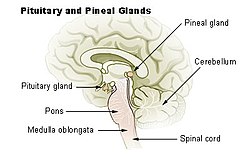
Diagram of pituitary and pineal glands in the human brain
| |
| Details | |
| Precursor | Neural ectoderm, roof of diencephalon |
| Artery | posterior cerebral artery |
| Identifiers | |
| Latin | glandula pinealis |
| MeSH | Pineal+gland |
| NeuroLex ID | Pineal body |
| TA | A11.2.00.001 |
| FMA | 62033 |
| Anatomical terms of neuroanatomy | |
Nearly all vertebrate species possess a pineal gland. The most important exception is the hagfish, which is often thought of as the most primitive extant vertebrate.[3] Even in the hagfish, however, there may be a "pineal equivalent" structure in the dorsal diencephalon.[4] The lancelet Branchiostoma lanceolatum, the nearest existing relative to vertebrates, also lacks a recognizable pineal gland.[3] The lamprey (considered almost as primitive as the hagfish), however, does possess one.[3] A few more developed vertebrates lost pineal glands over the course of their evolution.[5]
The results of various scientific research in evolutionary biology, comparative neuroanatomy and neurophysiology, have explained the phylogeny of the pineal gland in different vertebrate species. From the point of view of biological evolution, the pineal gland represents a kind of atrophied photoreceptor. In the epithalamus of some species of amphibians and reptiles, it is linked to a vestigial organ, known as the parietal eye which is also called the third eye.[6]
René Descartes believed the pineal gland to be the "principal seat of the soul". Academic philosophy among his contemporaries considered the pineal gland as a neuroanatomical structure without special metaphysical qualities; science studied it as one endocrine gland among many. However, the pineal gland continues to have an exalted status in the realm of pseudoscience.[7]
Contents
[hide]Structure[edit]
The pineal gland is the only midline brain structure that is unpaired (azygous). It takes its name from its pine-cone shape.[8] The gland is reddish-gray and about the size of a grain of rice (5–8 mm) in humans. The pineal gland, also called the pineal body, is part of the epithalamus, and lies between the laterally positioned thalamic bodies and behind the habenular commissure. It is located in the quadrigeminal cistern near to the corpora quadrigemina.[9] It is also located behind the third ventricle and is bathed in cerebrospinal fluid supplied through a small pineal recess of the third ventricle which projects into the stalk of the gland.[10]Blood supply[edit]
Unlike most of the mammalian brain, the pineal gland is not isolated from the body by the blood–brain barrier system;[11] it has profuse blood flow, second only to the kidney,[12] supplied from the choroidal branches of the posterior cerebral artery.Innervation[edit]
The pineal gland receives a sympathetic innervation from the superior cervical ganglion. A parasympathetic innervation from the pterygopalatine and otic ganglia is also present.[13] Further, some nerve fibers penetrate into the pineal gland via the pineal stalk (central innervation). Also, neurons in the trigeminal ganglion innervate the gland with nerve fibers containing the neuropeptide PACAP.Histology[edit]
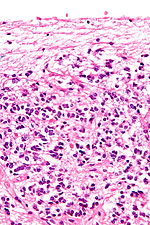
Micrograph of a normal pineal gland – very high magnification.
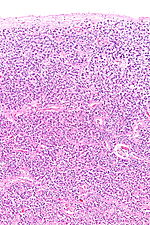
Micrograph of a normal pineal gland – intermediate magnification.
The pineal gland consists mainly of pinealocytes, but four other cell types have been identified. As it is quite cellular (in relation to the cortex and white matter), it may be mistaken for a neoplasm.[14]
| Cell type | Description |
|---|---|
| Pinealocytes | The pinealocytes consist of a cell body with 4–6 processes emerging. They produce and secrete melatonin. The pinealocytes can be stained by special silver impregnation methods. Their cytoplasm is lightly basophilic. With special stains, pinealocytes exhibit lengthy, branched cytoplasmic processes that extend to the connective septa and its blood vessels. |
| Interstitial cells | Interstitial cells are located between the pinealocytes. They have elongated nuclei and a cytoplasm that is stained darker than that of the pinealocytes. |
| Perivascular phagocyte | Many capillaries are present in the gland, and perivascular phagocytes are located close to these blood vessels. The perivascular phagocytes are antigen presenting cells. |
| Pineal neurons | In higher vertebrates neurons are usually located in the pineal gland. However, this is not the case in rodents. |
| Peptidergic neuron-like cells | In some species, neuronal-like peptidergic cells are present. These cells might have a paracrine regulatory function. |
Development[edit]
The human pineal gland grows in size until about 1–2 years of age, remaining stable thereafter,[18][19] although its weight increases gradually from puberty onwards.[20][21] The abundant melatonin levels in children are believed to inhibit sexual development, and pineal tumors have been linked with precocious puberty. When puberty arrives, melatonin production is reduced.[citation needed]Function[edit]
The primary function of the pineal gland is to produce melatonin. Melatonin has various functions in the central nervous system, the most important of which is to help modulate sleep patterns. Melatonin production is stimulated by darkness and inhibited by light.[22][23] Light sensitive nerve cells in the retina detect light and send this signal to the suprachiasmatic nucleus (SCN), synchronizing the SCN to the day-night cycle. Nerve fibers then relay the daylight information from the SCN to the paraventricular nuclei (PVN), then to the spinal cord and via the sympathetic system to superior cervical ganglia (SCG), and from there into the pineal gland.The compound pinoline is also claimed to be produced in the pineal gland; it is one of the beta-carbolines.[24] This claim is subject to some controversy.
Regulation of the pituitary gland[edit]
Studies on rodents suggest that the pineal gland influences the pituitary gland's secretion of the sex hormones, follicle-stimulating hormone (FSH), and luteinizing hormone (LH). In a study by Motta, Fraschini, and Martini (1967), a pinealectomy was performed on rodents. No change in pituitary weight was observed, however there was an increase in the concentration of FSH and LH within the gland. In this same study, administration of melatonin did not return the concentrations of FSH to normal levels, suggesting that the pineal gland influences the pituitary glands secretion of FSH and LH through some other transmitting molecule.[25]Drug metabolism[edit]
Studies on rodents suggest that the pineal gland may influence the actions of recreational drugs, such as cocaine,[26] and antidepressants, such as fluoxetine (Prozac),[27] and that its hormone melatonin can protect against neurodegeneration.[28]Clinical significance[edit]
Calcification[edit]
Calcification of the pineal gland is typical (1% of study participants) in young adults, and has been observed in children as young as two years of age.[29] The calcified gland is often seen in skull X-Rays.[29] Calcification rates vary widely by country and correlate with an increase in age, with calcification occurring in an estimated 40% of Americans by their 17th year.[29] Calcification of the pineal gland is largely associated with corpora arenacea also known as "brain sand".It seems that the internal secretions of the pineal gland inhibit the development of the reproductive glands, because, in cases where it is severely damaged in children, the result is accelerated development of the sexual organs and the skeleton.[30]
Some studies show that the degree of pineal gland calcification is significantly higher in patients with Alzheimer's disease vs. other types of dementia.[31]
Pineal gland calcification may also contribute to the pathogenesis of Alzheimer's disease and may reflect an absence of crystallization inhibitors.[31]
Calcium, phosphorus,[17] and fluoride deposits in the pineal gland have been correlated with aging, showing that, as the brain ages, more deposits collect.[32] By old age, the pineal gland contains about the same amount of fluoride as teeth.[32] Pineal fluoride and pineal calcium are correlated.[32]
Tumours[edit]
Tumours of the pineal gland are called pinealomas. These tumours are rare and 50% to 70% are germinomas that arise from sequestered embryonic germ cells. Histologically they are similar to testicular seminomas and ovarian dysgerminomas.[33]A pineal tumour can compress the superior colliculi and pretectal area of the dorsal midbrain, producing Parinaud's syndrome. Pineal tumours also can cause compression of the cerebral aqueduct, resulting in a noncommunicating hydrocephalus. Other manifestations are the consequence of their pressure effects and consist of visual disturbances, headache, mental deterioration, and sometimes dementia-like behaviour.[34]
These neoplasms are divided into three categories, pineoblastomas, pineocytomas, and mixed tumours, based on their level of differentiation, which, in turn, correlates with their neoplastic aggressiveness.[35] The clinical course of patients with pineocytomas is prolonged, averaging up to several years.[36] The position of these tumours makes them very difficult or impossible to remove surgically.
Other animals[edit]
Pinealocytes in many non-mammalian vertebrates have a strong resemblance to the photoreceptor cells of the eye. Some evolutionary biologists believe that the vertebrate pineal cells possess a common evolutionary ancestor with retinal cells.[37]Pineal cytostructure seems to have evolutionary similarities to the retinal cells of chordates.[37] Modern birds and reptiles have been found to express the phototransducing pigment melanopsin in the pineal gland. Avian pineal glands are believed to act like the suprachiasmatic nucleus in mammals.[38]
In some vertebrates, exposure to light can set off a chain reaction of enzymatic events within the pineal gland that regulate circadian rhythms.[39] Some early vertebrate fossil skulls have a pineal foramen (opening). This correlates with the physiology of the modern "living fossils," the lampreys and the tuatara, and some other vertebrates that have a parietal eye, which, in some of them, is photosensitive. The parietal eye represents evolution's earlier approach to photoreception.[40] The structures of the pineal eye in the tuatara are analogous to the cornea, lens, and retina, though the latter resembles that of an octopus rather than a vertebrate retina. The asymmetrical whole consists of the "eye" to the left and the pineal sac to the right. "In animals that have lost the parietal eye, including mammals, the pineal sac is retained and condensed into the form of the pineal gland."[40]
Fossils seldom preserve soft anatomy. The brain of the Russian Melovatka bird, about 90 million years old, is an exception, and it shows a larger-than-expected parietal eye and pineal gland.[41]
In humans and other mammals, the light signals necessary to set circadian rhythms are sent from the eye through the retinohypothalamic system to the suprachiasmatic nuclei (SCN) and the pineal gland.
Society and culture[edit]
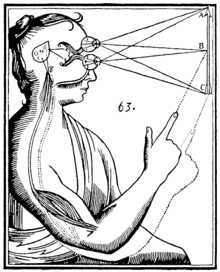
Diagram of the operation of the pineal gland for Descartes in the Treatise of Man (figure published in the edition of 1664)
The notion of a "pineal-eye" is central to the philosophy of the French writer Georges Bataille, which is analyzed at length by literary scholar Denis Hollier in his study Against Architecture. In this work Hollier discusses how Bataille uses the concept of a "pineal-eye" as a reference to a blind-spot in Western rationality, and an organ of excess and delirium.[44] This conceptual device is explicit in his surrealist texts, The Jesuve and The Pineal Eye.[45]
In the late 19th century Madame Blavatsky (who founded theosophy) identified the pineal gland with the Hindu concept of the third eye, or the Ajna chakra. This association is still popular today.[7]
Author and researcher Rick Strassman has theorised that the human pineal gland is capable of producing the hallucinogen N,N-dimethyltryptamine (DMT) under certain circumstances.[citation needed] In 2013 he and other researchers first reported DMT in the pineal gland microdialysate of rodents.[46]
History[edit]
The secretory activity of the pineal gland is only partially understood. Its location deep in the brain suggested to philosophers throughout history that it possesses particular importance. This combination led to its being regarded as a "mystery" gland with mystical, metaphysical, and occult theories surrounding its perceived functions.The pineal gland was originally believed to be a "vestigial remnant" of a larger organ. In 1917, it was known that extract of cow pineals lightened frog skin. Dermatology professor Aaron B. Lerner and colleagues at Yale University, hoping that a substance from the pineal might be useful in treating skin diseases, isolated and named the hormone melatonin in 1958.[47] The substance did not prove to be helpful as intended, but its discovery helped solve several mysteries such as why removing the rat's pineal accelerated ovary growth, why keeping rats in constant light decreased the weight of their pineals, and why pinealectomy and constant light affect ovary growth to an equal extent; this knowledge gave a boost to the then new field of chronobiology.[48]
See also[edit]
Additional images[edit]
The pineal body is labeled in these images.References[edit]
- Jump up ^ Macchi M, Bruce J (2004). "Human pineal physiology and functional significance of melatonin". Front Neuroendocrinol. 25 (3–4): 177–95. doi:10.1016/j.yfrne.2004.08.001. PMID 15589268.
- Jump up ^ Arendt J, Skene DJ (2005). "Melatonin as a chronobiotic". Sleep Med Rev. 9 (1): 25–39. doi:10.1016/j.smrv.2004.05.002. PMID 15649736.
Exogenous melatonin has acute sleepiness-inducing and temperature-lowering effects during 'biological daytime', and when suitably timed (it is most effective around dusk and dawn) it will shift the phase of the human circadian clock (sleep, endogenous melatonin, core body temperature, cortisol) to earlier (advance phase shift) or later (delay phase shift) times.
- ^ Jump up to: a b c Vernadakis AJ, Bemis WE, Bittman EL (April 1998). "Localization and partial characterization of melatonin receptors in amphioxus, hagfish, lamprey, and skate". Gen. Comp. Endocrinol. 110 (1): 67–78. doi:10.1006/gcen.1997.7042. PMID 9514841.
- Jump up ^ Ooka-Souda S, Kadota T, Kabasawa H (December 1993). "The preoptic nucleus: the probable location of the circadian pacemaker of the hagfish, Eptatretus burgeri". Neurosci. Lett. 164 (1–2): 33–6. doi:10.1016/0304-3940(93)90850-K. PMID 8152610.
- Jump up ^ Erlich SS, Apuzzo ML (September 1985). "The pineal gland: anatomy, physiology, and clinical significance". J. Neurosurg. 63 (3): 321–41. doi:10.3171/jns.1985.63.3.0321. PMID 2862230.
- Jump up ^ Eakin, Richard M. (1973). The Third Eye. Berkeley: University of California Press.
- ^ Jump up to: a b c d e Lokhorst, Gert-Jan (2015). Descartes and the Pineal Gland. Stanford: The Stanford Encyclopedia of Philosophy.
- Jump up ^ Bowen, R. "The Pineal Gland and Melatonin". Retrieved 14 October 2011.
- Jump up ^ http://www.ajnr.org/content/19/9/1631.full.pdf
- Jump up ^ Dorland's. Illustrated Medical Dictionary. Elsevier Saunders. p. 1607. ISBN 978-1-4160-6257-8.
- Jump up ^ Pritchard, Thomas C.; Alloway, Kevin Douglas (1999). Medical Neuroscience (Google books preview). Hayes Barton Press. pp. 76–77. ISBN 1-889325-29-5. Retrieved 2009-02-08.
- Jump up ^ Arendt J: Melatonin and the Mammalian Pineal Gland, ed 1. London. Chapman & Hall, 1995, p 17
- Jump up ^ Møller, M., Baeres, F.M.M. (2014). "The anatomy and innervation of the mammalian pineal gland". Cell Tissue Res. 309 (1): 139–150. doi:10.1007/s00441-002-0580-5. PMID 12111544.
- Jump up ^ Kleinschmidt-DeMasters BK, Prayson RA (November 2006). "An algorithmic approach to the brain biopsy—part I". Arch. Pathol. Lab. Med. 130 (11): 1630–8. doi:10.1043/1543-2165(2006)130[1630:AAATTB]2.0.CO;2 (inactive 2016-01-16). PMID 17076524.
- Jump up ^ Bocchi G, Valdre G (1993). "Physical, chemical, and mineralogical characterization of carbonate-hydroxyapatite concretions of the human pineal gland". J Inorg Biochem. 49 (3): 209–20. doi:10.1016/0162-0134(93)80006-U. PMID 8381851.
- Jump up ^ Baconnier S, Lang S, Polomska M, Hilczer B, Berkovic G, Meshulam G (2002). "Calcite microcrystals in the pineal gland of the human brain: first physical and chemical studies". Bioelectromagnetics. 23 (7): 488–95. doi:10.1002/bem.10053. PMID 12224052.
- ^ Jump up to: a b "IngentaConnect High Accumulation of Calcium and Phosphorus in the Pineal Bodies". Ingentaconnect.com. 2006-06-16. Retrieved 2009-07-06.
- Jump up ^ Schmidt, F; Penka, B; Trauner, M; Reinsperger, L; Ranner, G; Ebner, F; Waldhauser, F (Apr 1995). "Lack of pineal growth during childhood". J Clin Endocrinol Metab. 80 (4): 1221–5. doi:10.1210/JCEM.80.4.7536203. PMID 7536203.
- Jump up ^ Sumida, M; Barkovich, AJ; Newton, TH (Feb 1996). "Development of the pineal gland: measurement with MR". AJNR Am J Neuroradiol. 17 (2): 233–6. PMID 8938291.
- Jump up ^ Tapp, E; Huxley, M (1971). "The weight and degree of calcification of the pineal gland". J Pathol. 105 (1): 31–39. doi:10.1002/path.1711050105. PMID 4943068.
- Jump up ^ Tapp, E; Huxley, M (1972). "The histological appearance of the human pineal gland from puberty to old age". J Pathol. 108 (2): 137–144. doi:10.1002/path.1711080207. PMID 4647506.
- Jump up ^ Axelrod J (1970). "The pineal gland". Endeavour. 29 (108): 144–8. PMID 4195878.
- Jump up ^ Lowrey, Phillip L., and Joseph S. Takahashi. "Genetics of the mammalian circadian system: photic entrainment, circadian pacemaker mechanisms, and posttranslational regulation." Annual Review of Genetics 34.1 (2000): 533-562.
- Jump up ^ Callaway, James C.; Gyntber, Jukka; Poso, Antti; Airaksinen, Mauno M.; Vepsäläinen, Jouko (1994). "The pictet-spengler reaction and biogenic tryptamines: Formation of tetrahydro-β-carbolines at physiologicalpH". Journal of Heterocyclic Chemistry. 31 (2): 431–435. doi:10.1002/jhet.5570310231.
- Jump up ^ Motta, Marina; Fraschini, F.; Martini, L. (1967). "Endocrine Effects of Pineal Gland and of Melatonin.". Exp Biol Med (Maywood). 126 (2): 431–435. doi:10.3181/00379727-126-32468.
- Jump up ^ Uz T, Akhisaroglu M, Ahmed R, Manev H (2003). "The pineal gland is critical for circadian Period1 expression in the striatum and for circadian cocaine sensitization in mice". Neuropsychopharmacology. 28 (12): 2117–23. doi:10.1038/sj.npp.1300254. PMID 12865893.
- Jump up ^ Uz T, Dimitrijevic N, Akhisaroglu M, Imbesi M, Kurtuncu M, Manev H (2004). "The pineal gland and anxiogenic-like action of fluoxetine in mice". Neuroreport. 15 (4): 691–4. doi:10.1097/00001756-200403220-00023. PMID 15094477.
- Jump up ^ Manev H, Uz T, Kharlamov A, Joo J (1996). "Increased brain damage after stroke or excitotoxic seizures in melatonin-deficient rats". FASEB J. 10 (13): 1546–51. PMID 8940301.
- ^ Jump up to: a b c Zimmerman, Robert A. "Age-Related Incidence of Pineal Calcification Detected by Computed Tomography" (PDF). Radiological Society of North America. Retrieved 21 June 2012.
- Jump up ^ "The Pineal Body". Human Anatomy (Gray's Anatomy). Retrieved 2011-09-07.
- ^ Jump up to: a b Mahlberg, R.; Walther, S.; Kalus, P.; Bohner, G.; Haedel, S.; Reischies, F. M.; Kühl, K. P.; Hellweg, R.; Kunz, D. (2008). "Pineal calcification in Alzheimer's disease: An in vivo study using computed tomography". Neurobiology of Aging. 29 (2): 203–209. doi:10.1016/j.neurobiolaging.2006.10.003. PMID 17097768.
- ^ Jump up to: a b c Luke, Jennifer (March–April 2001). "Fluoride Deposition in the Aged Human Pineal Gland". Caries Res. 2001 (35): 125–128. doi:10.1159/000047443. PMID 11275672.
- Jump up ^ . p. 1137. ISBN 9780323296359. Missing or empty
|title=(help) - Jump up ^ Bruce, Jeffrey. "Pineal Tumours". eMedicine. Retrieved 25 September 2015.
- Jump up ^ "Pineal Tumours". American Brain Tumour Association. Retrieved 25 September 2015.
- Jump up ^ Clark, Aaron J.; Sughrue, Michael E.; Ivan, Michael E.; Aranda, Derick; Rutkowski, Martin J.; Kane, Ari J.; Chang, Susan; Parsa, Andrew T. (2010). "Factors influencing overall survival rates for patients with pineocytoma". Journal of Neuro-Oncology. 100 (2): 255–260. doi:10.1007/s11060-010-0189-6. PMC 2995321
 . PMID 20461445.
. PMID 20461445. - Jump up ^ Natesan A, Geetha L, Zatz M (2002). "Rhythm and soul in the avian pineal". Cell Tissue Res. 309 (1): 35–45. doi:10.1007/s00441-002-0571-6. PMID 12111535.
- Jump up ^ Moore RY, Heller A, Wurtman RJ, Axelrod J (January 1967). "Visual pathway mediating pineal response to environmental light". Science. 155 (759): 220–3. doi:10.1126/science.155.3759.220. PMID 6015532.
- ^ Jump up to: a b Schwab, I.R.; O'Connor, G.R. (March 2005). "The lonely eye". British Journal of Ophthalmology. 89 (3): 256. doi:10.1136/bjo.2004.059105. PMC 1772576
 . PMID 15751188.
. PMID 15751188. - Jump up ^ Kurochkin, Evgeny N.; Gareth J. Dyke; Sergei V. Saveliev; Evgeny M. Pervushov; Evgeny V. Popov (June 2007). "A fossil brain from the Cretaceous of European Russia and avian sensory evolution". Biology Letters. The Royal Society. 3 (3): 309–313. doi:10.1098/rsbl.2006.0617. PMC 2390680
 . PMID 17426009.
. PMID 17426009. - Jump up ^ Descartes R. "The Passions of the Soul" excerpted from "Philosophy of the Mind," Chalmers, D. New York: Oxford University Press, Inc.; 2002. ISBN 978-0-19-514581-6
- Jump up ^ Wikisource:Ethics (Spinoza)/Part 5
- Jump up ^ Hollier, D, Against Architecture: The Writings of Georges Bataille, trans. Betsy Wing, MIT, 1989.
- Jump up ^ Bataille, G, Visions of Excess: Selected Writings, 1927–1939 (Theory and History of Literature, Vol 14), trans. Allan Stoekl et al., Manchester University Press, 1985
- Jump up ^ Barker SA, Borjigin J, Lomnicka I, Strassman R (Jul 2013). "LC/MS/MS analysis of the endogenous dimethyltryptamine hallucinogens, their precursors, and major metabolites in rat pineal gland microdialysate". Biomed Chromatogr. 27 (12): 1690–1700. doi:10.1002/bmc.2981. PMID 23881860.
- Jump up ^ Lerner AB, Case JD, Takahashi Y (1960). "Isolation of melatonin and 5-methoxyindole-3-acetic acid from bovine pineal glands". J Biol Chem. 235: 1992–7. PMID 14415935.
- Jump up ^ Coates, Paul M. (2005). Encyclopedia of Dietary Supplements. Marc R. Blackman, Gordon M. Cragg, Mark Levine, Joel Moss, Jeffrey D. White. CRC Press. p. 457. ISBN 0-8247-5504-9. Retrieved 2009-03-31.
External links[edit]
| Look up pineal gland in Wiktionary, the free dictionary. |
| Wikimedia Commons has media related to Pineal gland. |
- gland Stained brain slice images which include the "pineal gland" at the BrainMaps project
- hier-280 at NeuroNames
- Histology at BU: Endocrine System: pineal gland (illustration)
- Anatomy Atlases, Microscopic atlas: Pineal gland
- MedPix: Images of Pineal region
- Studies of chinese original quiet sitting by using functional magnetic resonance imaging..
- Detection of nighttime melatonin level in Chinese Original Quiet Sitting.

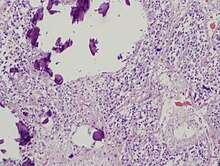



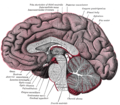


No comments:
Post a Comment